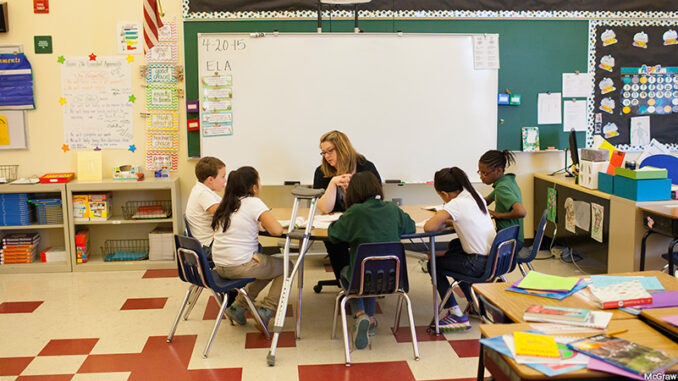

Right about now, more than 55 million kids are starting back to school in the United States. Thirty years ago, our nation’s education system was ranked one of the best in the world. Today, that brag is slipping further out of our grasp as our math rankings in particular continue to fall below our expectations. For each federal effort to improve our standards and raise our student’s test scores, there are always critics–made up of frustrated students, parents, teachers, community leaders and lawmakers. But because a well-educated citizenry has always been one of the key goals of the United States, the issue continues to receive national attention. Policymakers and educators continue to come up with strategies on the best way to educate our children.
As we enter into yet another school year, btw takes a closer look at some of the major education initiatives in recent decades and makes some assessments of their impacts.
Elementary and Secondary Education Act of 1965
President Lyndon Johnson was responsible for a large number of social reforms implemented in the 1960s. As a part of his larger War on Poverty initiative, the ESEA aimed to narrow the achievement gap between children of different socio-economic levels. The original legislation was divided into six sections (called Titles). Title I is the provision that allows for federal funds to those school districts with the highest percentage of students from low-income families. The Act has been “reauthorized” (updated or changed) several times since its adoption, usually in regard to how funds are used.
Improving America’s Schools Act of 1994
IASA was a major reauthorization of the ESEA, and signed into law by President Bill Clinton. Highlights include the implementation of charter schools (independently operated but funded through federal dollars) and drug-free school zones.
Outcome-Based Education
While not a piece of formal legislation, OBE is a educational practice that became popular in the 1990s. Instead of using rote-learning (memorization) and grades alone, OBE considers the individual needs of individual students. While considered largely successful, the fundamental challenge of OBE is that determining “appropriate” outcomes can be very subjective.
Program for International Student Assessment
Since 2000, the Organization for Economic Co-operation and Development had conducted the PISA every three years. This study evaluates and ranks the educational systems around the world. More than half-a-million students (only 15-year-olds are tested) from more than 65 countries are given tests to measure their abilities in math, reading, science and problem-solving. While it is considered the international standard, some question the validity of its methodology.
No Child Left Behind Act (2001)
NCLB is considered a reauthorization of the Education and Secondary Ed Act of 1965. While there was a lot of initial support for this law, but it became heavily criticized for its heavy use of standardized testing. In 2011, the U.S. Department of Education allowed states to “request flexibility” regarding NCLB requirements. To date, 45 states have applied for such flexibility.
Race to the Top
Part of the American Recovery and Reinvestment Act of 2009, RTTT is grant money that states compete for by meeting certain criteria. This includes educator performance, developing standards, turning around low-achieving schools and using data to improve instruction.
Common Core State Standards Initiative
Adopted in 2010, Common Core is a national education initiative co-sponsored by the National Governors Association and the Council of Chief State School Officers. It is a set of math and English standards that outline what students of each grade level should be expected to know upon completion of that grade. Some of the program’s initial supporters are now critical of the standards, calling them developmentally inappropriate, and often confusing.
Perhaps the biggest challenge in creating effective national education reform is finding a one-size-fits-most answer that works for everyone. In the meantime, issues such as achievement standards, standardized tests, school choice, class size and more money spent per student are likely to continue as long as we have schools.
